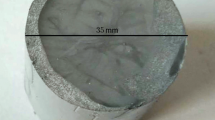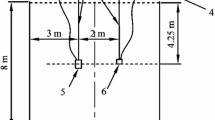Abstract
An underwater explosion test is used to determine the detonation properties of metallized explosives containing aluminum and boron powders. An oxygen bomb calorimeter (PARR 6200 calorimeter, Parr Instrument Company, USA) is used to obtain the heat of combustion of the metal mixtures. As the content of boron powders is increased, the heat of combustion of the metal mixtures increases, and the combustion efficiency of boron decreases. The highest value of the combustion heat is 38.2181 MJ/kg, with the boron content of 40%. All metallized explosive compositions (RDX/Al/B/AP) have higher detonation energy (including higher shock wave energy and bubble energy) in water than the TNT charge. The highest total useful energy is 6.821 MJ/kg, with the boron content of 10%. It is 3.4% higher than the total energy of the RDX/Al/AP composition, and it is 2.1 times higher than the TNT equivalent.
Similar content being viewed by others
References
A. E. Wildegger-Gaissmaier, “Aspects of Thermobaric Weaponry,” Mili. Tech. 28 6, 125–126 (2004).
N. H. Yen and L. Y. Wang, “Reactive Metals in Explosives,” Propell., Explos., Pyrotech. 37 2, 143–155 (2012).
M. A. Cook, A. S. Filler, and R. T. Keyes, “Aluminized Explosives,” J. Phys. Chem. 61 2, 189–196 (1957).
P. Brousseau, H. E. Dorsett, M. D. Cliff, et al., “Detonation Properties of Explosives Containing Nanometric Aluminum Powder,” in 12th Int. Detonation Symp. (2002).
A. Lefrancois, G. Baudin, and C. L. Gallic, “Coudoing, Nanometric Aluminum Powder Influence on the Detonation Efficiency of Explosives,” in 12th Int. Detonation Symp. (2002).
M. F. Gogulya, A. Y. Dolgoborodov, M. N. Makhov, et al., “Detonation Performance of Aluminized Compositions Based on BTNEN,” in 12th Int. Detonation Symp. (2002).
P. Brousseau and M. Cliff, “The Effect of Ultrafine Aluminium Powder on the Detonation Properties of Various Explosives,” in 32th Int. Annu. Conf. of ICT (Karlsruhe, 2001).
W. A. Trzcinski and S. Cudzilo, and L. Szymánczyk, “Studies of Detonation Characteristics of Aluminum Enriched RDX Compositions,” Propell., Explos., Pyrotech. 32 5, 392–400 (2007).
W. A. Trzcinski, S. Cudzilo, and J. Paszula, “Studies of Free Field and Confined Explosions of Aluminium Enriched RDX Compositions,” Propell., Explos., Pyrotech. 32 5, 502–508 (2007).
R. Schaefer and S. M. Nicolich, “Development and Evaluation of New High Blast Explosives,” in 36th Int. Annu. Conf. of ICT (Karlsruhe, 2005).
S. H. Fischer and M. C. Grubelich, The Use of Combustible Metals in Explosive Incendiary Devices (Sandia National Lab., 1996).
S. H. Fischer and M. C. Grubelich, “Explosive Dispersal and Ignition of Combustible Metals and Thermite Formulations,” in 46th Annu. Bomb and Warhead Tech. Symp. (1996).
P. E. Anderson, P. Cook, A. Davis, et al.. “Silicon Fuel in High Performance Explosives,” Propell., Explos., Pyrotech. 39 1, 74–78 (2014).
K. Kuo, K. Editors, and R. Pein, Combustion of Boron-Based Solid Propellants and Solid Fuels (Begell House, 1993).
A. Maćek and J. M. Semple, “Combustion of Boron Particles at Elevated Pressure,” in Proc. of 13th Symp. (Int.) Combust. (1971). pp. 859–868.
A. Maćek and J. M. Semple, “Combustion of Boron Particles Atatmospheric Pressure,” Combust. Sci. Technol. 1 3, 181–191 (1969).
A. Maćek, “Combustion of Boron Particles: Experiment and Theory,” Symp. Combust. Proc. 1401–1411 (1973).
J. G. Speight, Lange’s Handbook of Chemistry (McGraw-Hill, New York, 2005).
E. C. Koch and T. M. Klapötke, “Boron-Based High Explosives,” Propell., Explos., Pyrotech. 37 3, 335–344 (2012).
M. Makhov, “Explosion Heat of Boron-Containing Explosive Composition,” in 35th Int. Annu. Conf. of ICT (Karlsruhe, 2004).
K. Lee K. Lee, and J. Kim, “Relationship between Combustion Heat and Blast Performance of Aluminized Explosives,” in 36th Int. Annu. Conf. of ICT (Karlsruhe, 2005).
ASTM D240-02. Standard Test Method for Heat of Combustion of Liquid Hydrocarbon Fuels by Bomb Calorimeter (2007).
T. Katsume, “Precisely Measure Explosive Energy Using Explosive Underwater Method,” Kogyo Kayakua 4 4, 239–245 (1981).
G. Bjarnholt and R. Holmberg, “Explosive Expansion Works in Underwater Detonations,” in Proc. 6th Symp. on Detonation (1976).
A. B. Arons and D. R. Yennie, “Energy Partition in Underwater Explosion Phenomena,” Rev. Mod. Phys. 20 3, 519–535 (1948).
M. M. Swisdak, “Explosion Effects and Properties. Pt II: Explosion Effects in Water,” DTIC Document (1978).
R. H. Cole, Underwater Explosions (Princeton Univ. Press, Princeton, 1948).
M. B. John, “Numerical Modelling of Shock Wave and Pressure Pulse Generation by Underwater Explosions,” Tech. Report No. DSTO-TR-0677 (Australian, 1998).
Author information
Authors and Affiliations
Corresponding author
Additional information
Published in Fizika Goreniya i Vzryva, Vol. 52, No. 3, pp. 97–104, May–June, 2016. Original article
Rights and permissions
About this article
Cite this article
Xu, S., Chen, Y., Chen, X. et al. Combustion heat of the Al/B powder and its application in metallized explosives in underwater explosions. Combust Explos Shock Waves 52, 342–349 (2016). https://doi.org/10.1134/S001050821603014X
Received:
Accepted:
Published:
Issue Date:
DOI: https://doi.org/10.1134/S001050821603014X




